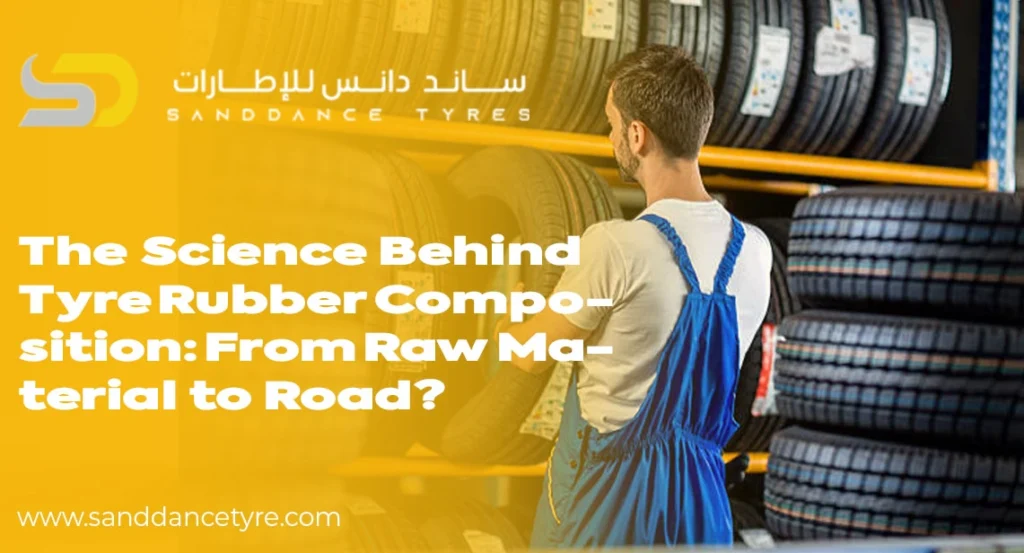When it comes to tires, you may think of their grip, wear over time, or performance on the road. What you may not know is that what defines a tire’s behavior is very scientific: the tyre rubber composition. At Sand Dance Tyre, we are of the mind that to truly appreciate the performance, safety, and durability of your tires, it is important to understand what is in the rubber. The process from raw rubber to a finished tire is a study in chemistry, engineering, and innovation. Let’s look at the science that turns natural materials into high-performance road partners.
Read More: How to Pay Traffic Dubai Police Fines Online in UAE: Step-by-Step Guide
Understanding Tyre Rubber Composition
Tyre rubber composition is a complex mix of many materials that we put together for optimal performance in extreme situations. What we think of as tyre rubber is a mix of natural vs synthetic rubber, carbon black, silica, oils, sulfur, and chemical accelerators. We tailor this mix to the tyre’s function for high speed, for rough terrain, or for a smooth long distance ride.
Each tire’s makeup plays a role in its total function. For example, natural rubber is used for flexibility and tensile strength, which is also increased by the use of synthetic rubber, which we include for improved wear and temperature performance. Also, we have fillers like carbon black and silica, which will enhance durability, grip, and rolling resistance, which in turn are very key elements in tire compound science.
Natural vs Synthetic Rubber: The Key Differences
In the discussion between natural vs synthetic rubber, which plays out in tyre manufacturing. Natural rubber, which comes from the latex of rubber trees, is known for its great flexibility and strength. It also has better tear resistance and is particularly valuable in truck and heavy-duty tyres, which require high load-bearing capabilities.
Synthetic rubber is a product of petroleum, and we produce it to have certain features like heat resistance, wear resistance, and consistent performance in many environmental settings. Tyres usually use a mix of both; we put in what each type does best. In Pakistan and the UAE, which have very different temperature ranges and road conditions, the right mix of natural vs synthetic rubber is what we use to make tires that do well in hot asphalt and rough terrain.
The Role of Tyre Compound Science
Tyre compound science is that which deals with the formulation of rubber compounds for which a tyre is to perform as intended. In different sections of the tyre, for instance, the tread, the sidewall, and the inner liner, we see different performance requirements which are met by varying compound types.
Tread compound is for grip and wear resistance; at the same time, sidewall compound is for flexibility and impact absorption. In terms of modern-day tire compound science, we have seen the introduction of materials like silica, which in turn reduces rolling resistance and improves fuel efficiency, which is a very important issue for eco-conscious drivers.
The Curing Process: Finalizing the Tyre’s Properties
Once the rubber compound is mixed, we see what is called the vulcanization or curing process. In this, the rubber is heated with sulfur, which in turn forms cross-links between polymer chains. This chemical reaction changes the once sticky and pliable rubber into a tough elastic material, which can also return to its original shape when stressed.
The key to a tyre’s final performance is in the curing process. It is out of this process comes the tyre’s strength, flexibility, as well as how it handles heat build-up, deformation, and wear over time. A tyre that is cured just right will perform better on the road, handle corners better, and will also be a safer option.
At Sand Dance Tyre, we are focused on tires that have gone through exact and high-quality curing. We see to it that every tire we put out meets international standards for safety, performance, and durability.
Why Tyre Rubber Composition Matters for You
For most people, the issue of what goes into tyre rubber may not be at the front of their mind, but it does play a large role in how they drive each day. What may not be known is that from performance on winding roads to that extra grip during rainy weather, the rubber inside of your vehicle’s tires is a big player. In some areas, like the UAE, that see very hot climates, which in turn cause quick wear out of low-quality tires, the role of the right rubber compound is of even more importance.
At Sand Dance Tyre, we provide our customers with the choice of tires that best fit their environment, in which they drive, and which also meet safety standards. We at Sand Dance Tyre study the science of rubber to present to you not just any tire, but performance, safety, and peace of mind in every trip you take.
FAQs
What do we see as the distinction between natural vs synthetic rubber in tires?
Natural rubber is flexible and strong, but synthetic rubber is designed for heat and wear resistance. Tyres usually put together a mix of both for the best performance.
Why is tyre rubber composition important?
The makeup of a tire determines its grip, durability, and heat resistance, which in turn affects performance.
What do we mean by the term curing in tire manufacturing?
Curing, also known as vulcanization, is a heating process that hardens rubber, thus giving tyres their strength and elasticity as well as their definite shape.
What role does tyre compound science play in performance?
Manufacturers are able to design various components of the tyre for particular functions, which in turn produce a complete and high-performance product.















